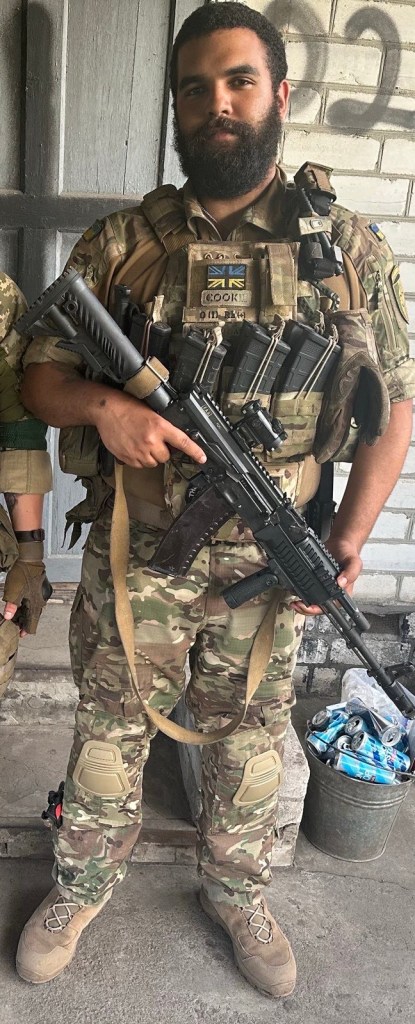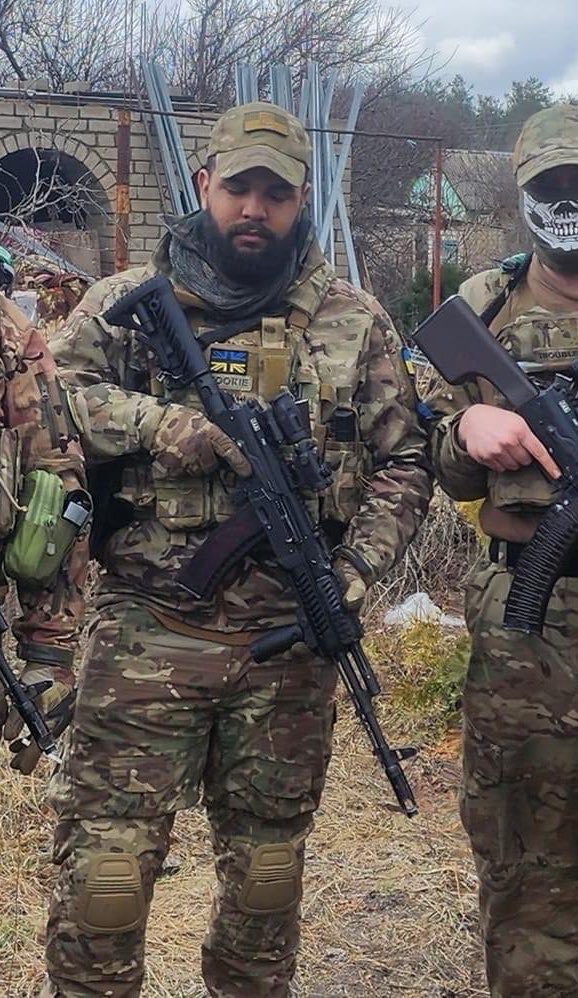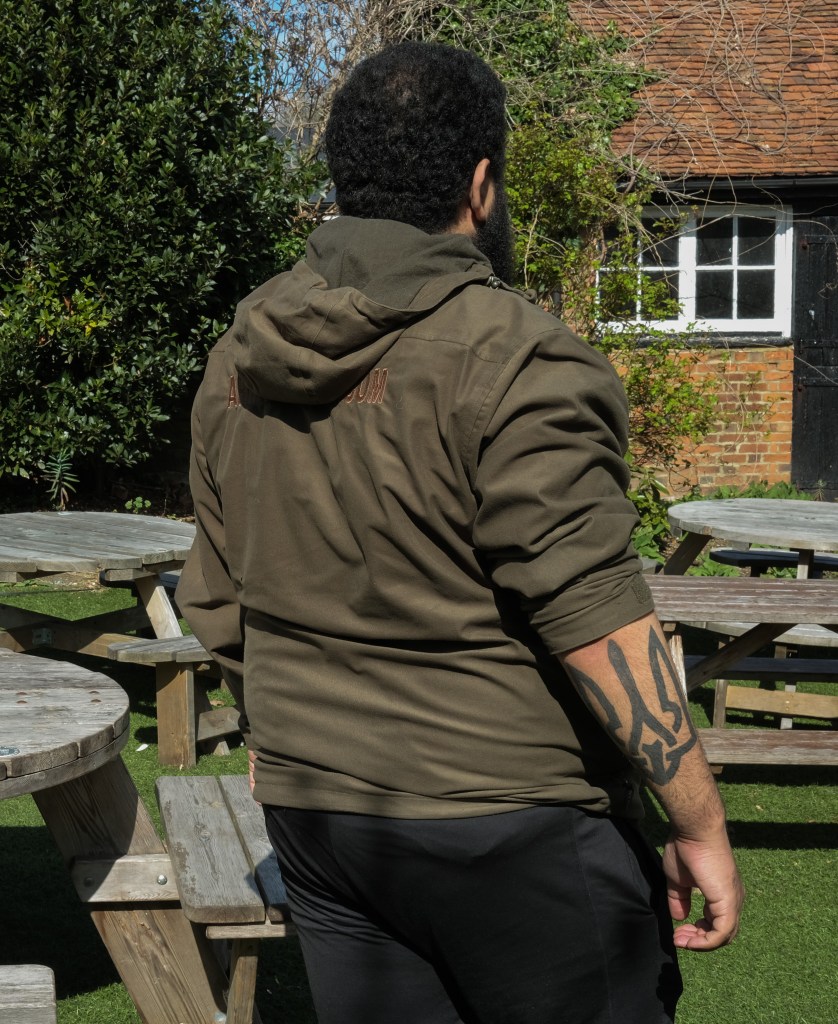In the weeks after Reece Searle returned home from Ukraine in September 2023, he lay awake at night, wishing he’d never left. In bed, he scrolled on his phone for hours, letting his thumb hover above flights to Poland—a gateway back to the war. Withdrawal from the highs of combat hit him hard, leaving a pit of emptiness in his chest.
Searle, a former police officer in Britain, had spent nine months fighting with the Ukrainian International Legion, a military unit of foreign volunteers mustered to help fend off the Russian invasion. As part of the Legion’s Special Services Group—an elite detachment within its broader framework—he saw combat for the first time, then terrible amounts of it. Fear gripped him now and then, but it usually did so with a weak fist; more often, he found himself furnished with a sense of clarity and excitement.
Back in his hometown, in a quaint suburb north of London, the countryside’s bluebell woods and lush gardens cut a striking contrast to the welter of destruction Searle witnessed in Ukraine. Away from the front, the vicissitudes of civilian life became hard to square, and he struggled to find motivation for even the most minor of tasks. “If I don’t do this, no one is going to die,” became a refrain he’d use to burnish his bouts of listlessness. The same went for his PT exercises. He gained weight. The sloping shoulders and broad hips that had once given him an angular, linebacker-like build disappeared under a puffy Falstaffian plumpness.
At the same time, the invisible damage Searle incurred at the front began to mount. Nightmares rattled loose his worst memories, forcing him to relive them nightly. His mother often found him screaming in his sleep. Loud noises left him skittish and on edge. Once, while walking through his neighborhood, he heard the buzz of a commercial drone and nearly bolted for cover.
At the behest of his friends and family, Searle eventually sought out treatment. He met with a therapist for a short time, and said the sessions helped lessen some of his more acute symptoms—his nightmares, his slew of triggers. Feeling better, he even took on some part-time work as an armorer for a television show, but soon lost interest. Days lapsed back into a dull procession of sameness—walking the dog, cooking dinner, going to the pub.
Still restless, he continued to fantasize about his memories from Ukraine, a preoccupation that helped leaven his ennui but was not without its limits. When he invariably reached them, falling back into boredom, he’d throw his legs over the intestines of his Yamaha and tear dangerously down country roads, letting the motorcycle’s big block engine heave beneath him. Activities that once held little appeal—first-person shooters, extreme sports—took on outsized roles in his life. He learned to skydive, going as far as to get his pilot’s license. Anything that could replicate the rush of being shot at again.
As the months passed, Searle weighed returning to the police department—pretty much the only job he’d ever had—but by then his need for adrenaline had grown into a needling provocation, one he feared would cause him to stir up violence rather than prevent it.
Searle (pictured below) had become, at 26, a veteran tormented by the realization that combat was something he might not be able to live without.

War is not always hell. One of its sharpest paradoxes is its allure, the way it traps men in its siren song, a chorus of myth-making qualities it often does possess. History teems with variations on this leitmotif: The ancient Greeks adopted the Homeric concept of aristeia, or martial excellence, from The Iliad, going as far as to order much of their culture around it. Centuries later, Confederate soldiers wrote of charging Union lines with a “wild, unexplainable enthusiasm,” feelings echoed in the memoirs of many Vietnam veterans.
Hollywood has promulgated this idea, too. In the summer of 2009, the American war action thriller The Hurt Locker played in more than 500 theaters across the country. Based on the account of freelance journalist Mark Boal, the film follows an American bomb squad deployed during the Iraq war and takes at face value the compensatory pleasures some of its men take in combat. Guy Westwell, writing for Sight & Sound, cautioned that the film’s “unapologetic celebration of a testosterone-fueled lust for war may gall,” but averred, “There is something original and distinctive about [its] willingness to admit that for some men (and many moviegoers) war carries an intrinsic dramatic charge.”
Despite veterans saying as much, there’s little in the way of scholarly research looking at how the dependency soldiers form on warfare shapes their lives once they leave the battlefield. The small cadre of psychologists who have studied “combat addiction,” as it’s known, insist it may be the most pervasive yet unrecognized form of PTSD affecting U.S. troops returning from the Middle East. And they warn it can be a big problem.
This alarm-raising comes at a time when PTSD has rapidly become the signature injury of military veterans. As many as half of those who served in Iraq or Afghanistan reported significant combat stress symptoms after their deployment. The demand for effective treatment has soared, yet veterans simply aren’t seeking out help. Even for those who eventually do, dropout rates remain stubbornly high. One study found that only between roughly 10 percent to 50 percent of U.S. and Canadian veterans with mental health issues receive care after deployment.
In lieu of treatment, combat veterans often look to drugs or fast driving to make themselves feel whole again, to shiver with thrill. Others know no synthetic exists and find their way back to the battlefield. Research shows that service members who deployed were more likely to reenlist than those who had not, and that when they do, they often seek out returning to combat roles as opposed to non-combat ones. Few studies have endeavored to find out why.
“In interviews, they described slipping into a heightened, whirlwind-like state while engaged in combat, only later to recoil at how much they enjoyed it”
In the late ‘80s and early ‘90s, psychologists began to observe troubling patterns in Vietnam veterans diagnosed with chronic PTSD. After returning from their deployment, some reenacted combat scenarios outdoors, maintained loaded weapons in their homes, and went looking for fights—bursts of excitement inevitably followed by emotional crashes, a cycle that looked a lot like substance abuse. In interviews, they described slipping into a heightened, whirlwind-like state while engaged in combat, only later to recoil at how much they enjoyed it.
Their experiences presaged a crisis that would emerge into public consciousness decades later, as PTSD became the invisible wound of the misbegotten War on Terror. Along with traumatic brain injuries, it was by far the most common—and most talked about—post-deployment health issue. Increased media attention led to greater public awareness, prompting the U.S. military to regard it more rigorously than they had in the past. In 2005, the Department of Defense introduced an expanded mental health screening intended to catch delayed-onset symptoms of PTSD months after soldiers returned home. Then, in 2008, Congress passed the Veteran’s Mental Health and Other Care Improvements Act, which funneled additional resources to the National Center for Posttraumatic Stress Disorder.
Still, the notion that combat veterans could be in thrall to the most violent aspects of war remained a backwater idea.
“It landed with a thud,” said Marjorie Campbell, former research director for the Defense Centers of Excellence for Psychological Health and Traumatic Brain Injury. “The academic community invested a great amount of time and money into the paradigm that PTSD is tragic, and that we need to feel sorry for the service members it afflicts.” Backpedaling on the myth of the American war hero now would potentially gainsay decades of credible work, not to mention the queasy moral questions it would raise about how we palliate returning soldiers. “The old guard doesn’t want to change. They would look foolish if they overlooked something like this,” she said.
“A brutal catch-22 about combat PTSD is that, for many veterans, anxiety and pleasure can become tightly latticed within the same traumatic event, a complexity that often disguises the issue”
Campbell first encountered signs of combat addiction while treating Marines at Camp Pendleton’s concussion clinic in 2011. Many of the men she therapized remained hyperaroused even after their traumatic memories had been cleared. They spent hours playing Call of Duty: Modern Warfare, rewatching bodycam footage from their deployment, and even visualized firefights while working out, to lift more weight. In wake of the Sandy Hook and Aurora shootings in 2012, many told her they planned to guard schools and movie theaters. Others fantasized incessantly about ISIS coming to their door. “They would patrol their houses, checking in cabinets and closets,” she said. “It gave them an excuse to be hyperaroused.”
In 2016, Campbell led a study looking at the prevalence of PTSD symptoms and combat attachment behaviors in veterans. Her findings supported much of what she had discerned in practice: her patients spent an average of five hours per day enacting combat attachment behaviors, and most reported regularly engaging in combat-related activities that, while rewarding, were also linked with distressing memories.
A brutal catch-22 about combat PTSD is that, for many veterans, anxiety and pleasure can become tightly latticed within the same traumatic event, a complexity that often disguises the issue. “They’ll acknowledge that they’re irritable, but they can’t link that to their positive thoughts about combat,” Campbell said. “They have no clue.”
Many veterans are reluctant to work through those experiences, since doing so could jar them into a vivid awareness of why they felt so good in the first place. Their guilt stems less from what they did than from the pleasure they took in doing it. Caught between the poles of thrill and shame, some eschew treatment altogether.
For those who can squarely face their pasts, many fear resolving their attachments could paper over their sense of self. War minted them as soldiers, wiping away who they were before. Back home, fantasies and flashbacks are sometimes all that keep them moored to their post-deployment identities as veterans. Absent those reminders, they question what’s to stop them from drifting into the doldrums of civilian life.
Because of this, treatment outcomes vary wildly. Some veterans progress through therapy just fine, leaving their traumas at the threshold of their past. Others aren’t so lucky. Jim Grigsby, a professor of psychology at the University of Colorado Denver, recalled a former student of his, a veteran and experienced jump instructor, whose chute failed to open during a recreational jump. When investigators arrived, they were quick to rule out suicide, suspecting he had waited to the absolute last second to deploy it. “We see some unfortunate stuff like that,” Grigsby said.
When I contacted the Defense Health Agency’s Psychological Health Center of Excellence— the Department of Defense organization where Campbell once worked—a spokesperson confirmed that “combat addiction” is not recognized by their clinical practice guidelines. When patients do present with PTSD symptoms that align with the concept, their providers look to the most effective evidence-based treatments. But if the condition isn’t formally acknowledged, let alone studied, how effective can those treatments truly be?
When Vladimir Putin launched his “special military operation” into Ukraine at the end of February, 2022, Searle (pictured right in Ukraine) was still working in law enforcement, his first job out of secondary school. An avid history buff from a military family, he followed the conflict with an attentive eye. As it became clear that the Kremlin’s offensive marked a full scale military campaign rather than empty aggression, he grew incensed, questioning why more wasn’t more being done to safeguard Ukraine’s sovereignty. He volunteered for charities that supported the war effort. He donated clothing.
By December of that year, Searle notified his police department that he was quitting. News clips of thin children fleeing the country reminded him of his 3-year-old son, what he later described to me as his road-to-Damascus moment. “I couldn’t watch from the sidelines,” he said. “I thought, well, I’m young, I’m fit—why not? They need men. I’m here. Let’s go.”

By then, Ukrainian President Volodymyr Zelenksy had announced the formation of the International Legion, inviting foreign fighters to join. They would be granted the same status as Ukrainian soldiers—military rank, salary, training, and legal protection under the Geneva Convention, including Prisoner of War status if captured. But unlike regular enlistment, their service would be considered voluntary. They could leave at any time.
Searle applied, but was rejected after an initial screening.
The Legion maintains a scrupulous vetting process, partly to prevent gun nuts from running roughshod over chain of command, but also for conventional security reasons, like espionage. Previous military experience, which Searle lacked, was a big help. Still, a few days after his application was declined, he got a call from a military liaison letting him know the Legion had reconsidered.
Searle left for the airport the next day. He told no one where he was going. He flew from London to Poland, then boarded a bus with a few other volunteers to Lviv. He brought a duffel bag containing body armor and some loose tactical gear, but little else.
When he arrived, Ukraine was in the throes of violence not seen in Europe since World War II. Prior to the 2022 invasion, wholesale state-on-state conflicts in Europe were relatively rare. The battle lines and territorial fighting of the past had been supplanted by the precise counterinsurgency campaigns of recent decades. In regions like Afghanistan and Iraq, Western militaries relied on high-flying stealth drones, satellite-based targeting systems, and small strike teams to brutalize extremist groups, who survived on guerrilla tactics to make up for their lack of advanced weaponry.
By contrast, the defining feature of the Ukrainian theater was its sprawling front, which extended hundreds of miles across mostly rural farmland and delineated each side’s advance. The country’s vast plains, called steppes, strengthened the effectiveness of heavy artillery, which is more accurate across level ground. Much of Russia’s arsenal consisted of such systems inherited from the Soviet Union, which considered artillery the “god of war” and produced great quantities of it during the Cold War.
Searle’s first gun battle came three months into his deployment, in March 2023. For weeks before, the dismal Ukrainian winter had put a hold on close fighting and his unit found themselves the prize of Russian gunners, who rained artillery down on their position with impunity. Each blast swallowed the next, creating a constant, industrial rumble.
Russian shelling was sloppy and indiscriminate: whether you lived or died had no bearing on your talent for soldiering. The randomness irked Searle, but he saw others grow insane with fear from it. Even hardened fighters with combat experience in the Middle East were unprepared for the atavism of trench warfare. Some simply packed up and went home. “When you’re being shelled, all you can do is sit in your hole and hope that the next one doesn’t land on you or your mate,” he said. “It’s shit for your morale. At least in a firefight things are a bit more even. It’s a more honest form of fighting.”
“They tried to kill me and they couldn’t […] I had a bit of a dodgy god-complex after that. It really was like the most powerful drug I’ve ever taken”
One night, while standing watch along the trench line, Searle heard faint rustling across a bosky embankment to his right. He ignored it, calmed by false alarms that had turned out to be nothing more than a field mouse, a stray dog. Rifle fire trailed off somewhere in the distance.
As he slouched back into his foxhole, something shivered past his head, followed by a sharp crack. A muzzle flash blinked in the darkness. Silence gave way to a jumble of noise—machine guns belched into action as his teammates returned fire, their bullets streaming out in long sighs. Russians were attempting to move on their position by taking advantage of a warren of tree lines that criss crossed no man’s land, territory neither side firmly controlled.
Searle felt his heart ram around in his chest. He was awash in a bath of epinephrine and norepinephrine, twin hormones produced in the adrenal glands that ready our body’s “fight or flight” response. When sent from our sympathetic nervous system, the effects are instantaneous: pupils dilate, airways widen to draw in more oxygen, blood reroutes away from non-essential systems like digestion to flood major muscle groups, blood clots more easily, and the liver dumps glycogen into the bloodstream for quick bursts of energy.
Paradoxically, the same mechanism meant to keep Searle alive threatened to betray him. “Trying to do anything fiddly when you’re dosed up on enough adrenaline to kill a small horse is a bit of a nightmare,” he told me. “Your hands start to shake and then they just don’t really work anymore. You get this red mist that causes you to lose senses that are less important, so your comprehension of your surroundings disappears.”
Steeling his renegade nerves, Searle eventually managed to slam off the safety on his AK-47 and join the skirmish. “I was rattling off rounds just in the Russians’ general direction,” he said. “I’ll be honest with you, we couldn’t even fucking see each other. I don’t know who hit who—it was just fucking chaos.“
The din of fighting drowned out reports from Russian mortars, leaving Searle’s team with no warning before more shells arrived; all they heard were thin screeches followed by an arpeggio of explosions, sending shrapnel leaping toward them.
As the marathon bombardment continued, keeping Searle’s team pinned in place, the rifle fire gradually petered out. The Russians—likely a small reconnaissance unit—abandoned whatever it was they were after and retreated.
Searle remembers crouching in his foxhole and watching as tremors ran through his hands. A euphoria of palpable weight settled over him. “From that point, I just thought, ‘Well shit, I’ve just been in a firefight, I’m the fucking man. They tried to kill me and they couldn’t,’” he said. “I had a bit of a dodgy god-complex after that. It really was like the most powerful drug I’ve ever taken.”
Searle’s high was fueled by dopamine, a neurotransmitter central to the brain’s pleasure and reward systems. When prompted by a stimulus—say, the savor of a hearty meal—the ventral tegmental area sends dopamine to the nucleus accumbens, the so-called “pleasure center,” where it kindles a sense of delight. Elsewhere in the brain, the hippocampus and prefrontal cortex weave the experience into memory and link it to emotional resonance. The result is a kind of neurochemical lesson: behaviors that signal this cascade are reinforced.
The dopamine reward system, one of the brain’s oldest mechanisms, evolved to promote survival by encouraging essential behaviors like eating, mating, and seeking safety. But this same system proves immensely vulnerable to modern vices. Drugs, alcohol, gambling, and gaming can hijack its circuitry, generating dopamine surges much greater than those produced naturally. Over time, the brain begins to conflate these addictive experiences with survival itself, prioritizing them above all else.
Combat tends to have this narcotic charm, too, but magnified tenfold, twentyfold. The chemical release it triggers is comparable to shooting a speedball of cocaine and heroin. Yet, as with those drugs, the brain grows desensitized with repeated stimulation, requiring ever-larger or more frequent doses to sustain the high.
By the end of Searle’s deployment, he said he definitely felt combat’s sheen begin to dull, so much so that it felt dissatisfyingly routine. He was not blind to the risk in this. “When you start to chase the dragon, you start to forget logic,” he said. “All you care about is getting that feeling again, so you might get a little more reckless, more keen to engage.” For some soldiers, combat becomes both the sickness and the cure.
“Notorious for doxxing foreign fighters, the group published his address, where he went to school, and even the name of his former partner”
On a Friday that felt like the first of spring, I met Searle for a pint at his local pub. The sun had finished chasing off the morning clouds, so he suggested we sit in the garden out back. Sipping the foam head from his glass, he appeared luminous and youthful seated across from me, no longer looking the part of a soldier.
Most of Searle’s unit left Ukraine in September 2023. The intensity of the fighting had kicked up over the summer; guys were getting killed on their way into missions, and the Quick Reaction Forces (QRF) sent in to bail them out were getting hit, too. Things got so bad Searle believed that if he stayed at the front much longer, it was only a matter of time until he wound up dead. His teammates agreed that they had all earned a little rest, so after some discussion they decided to terminate their contracts together.
A few days later, Searle was back home in Hertfordshire. Worn down by the privations of enlisted life, he drew a warm bath as soon as he got home. “I sat in the tub until it was cold and I was a prune,” he said. “Then I got out and sat on the toilet. I didn’t even have to go, I just sat on it and gave it the occasional flush.”
Nothing much had changed since I spoke to him in the fall. He told me he still looked for a rush in most things, though seemed to maintain a notional desire for a workaday existence. He recently rescued a dog from a shelter in Kyiv, driving all the way to Germany to collect her. He named the dog Masha. “I think I just need to try and prove to myself that I can lead a normal life,” he said. “And if I can’t do that, then the front is always there, I can always go back to it.”
Some of Searle’s teammates already had, and part of him thought about following suit. Distance from the front had solidified his reasons for joining the Legion in the first place: he viewed Russian irredentism as evil writ large, and when it came to defending the Ukrainian people, he had no moral forbearance. The time he spent in-country, fighting alongside local troops, only strengthened his convictions.
But the calculus Searle used to weigh his return seemed like a kind of grim arithmetic. With casualty rates what they were (high), he doubted his luck would hold and tried to take stock of his life in no uncertain terms. “I’m no use to my family and friends if I’m dead,” he said. “But how many 25 or 26-year-old Ukrainian men are not there for their families because they’ve been killed? How many can we, as Legionnaires, save by being there?”
There was something else weighing on him. A couple of months ago, he got a phone call from a former teammate of his who told him his name and photo had been posted on a pro-Russian Telegram channel called TrackANaziMerc. Notorious for doxxing foreign fighters, the group published his address, where he went to school, and even the name of his former partner.
When I asked Searle if he was concerned, noting that TrackANaziMerc had been linked to Russian security forces, he shifted his position and shrugged insouciantly, “If they were going to do something, they wouldn’t have posted me online,” he said. “It’s just a scare tactic.”
Searle, who is half-Namibian, found it amusing that out of the thousands of soldiers to appear on the Telegram channel, he was the only Black guy. “I was the only one they weren’t calling a Nazi!”

All the same, one could see how this development might figure into his decision on whether or not to rejoin the Legion. He was no longer nameless, faceless; now it was the Russians who had turned into some close but invisible thing. Maybe the trench line offered a way to bring them back into view.
As the morning turned to afternoon, the sun crossed the garden and the clouds marched back in. Pub-goers at neighboring tables shuffled inside. We made to follow, our glasses clinking empty. Before we said our farewells, Searle shimmied up the sleeve of his olive drab anorak, revealing a Ukrainian trident that ran from his elbow to his wrist. He swiveled his arm. The tattoo’s shading was mottled, some of its lines leaned at curious angles and its whole orientation was off—clearly the work of one of his teammates.
“We all have one somewhere on our bodies,” he said, before rolling his sleeve back down. “It’s our way of remembering.” His eyes darkened, aging the boyish lineaments of his face. “I think there’s a part of me still sitting in a hole in Luhansk.”
Follow Matt Mitchell on X @Matthew26510649
The post Thrill and Shame: The Soldiers Addicted to War appeared first on VICE.




